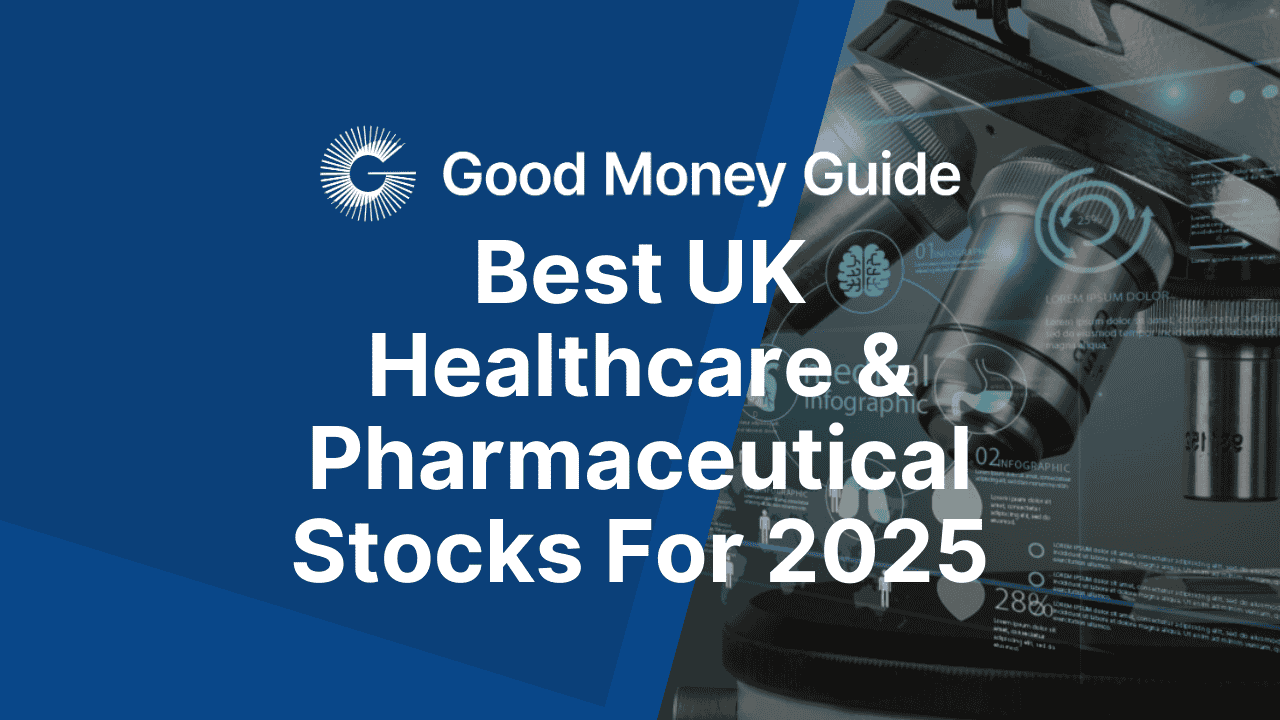Healthcare is a sector with immense long-term growth potential. Over the next decade, demand for healthcare solutions is projected to rise significantly as the global population ages and the prevalence of chronic diseases increases.
When it comes to healthcare stocks, UK investors have many options, ranging from FTSE 100 pharma giants to small companies listed on the AIM. Here’s a look at some of the best LSE-listed healthcare stocks to consider for 2025.

Best Large-cap healthcare stocks
AstraZeneca
AstraZeneca (AZN:LON) is a biopharmaceutical company that specialises in oncology, cardiovascular and metabolic diseases, and respiratory, inflammation and autoimmune diseases, and has around 200 drugs in its pipeline. A constituent of the FTSE 100, it currently has a market cap of around £162 million (making it the largest company on the London Stock Exchange).
In recent months, the AstraZeneca share price has fallen due to regulatory investigations into practices in China (this is an ongoing risk). Disappointing drug trial results have also hurt the stock.
I believe this weakness has created a decent buying opportunity for long-term investors. Currently, the price-to-earnings (P/E) ratio using the 2025 earnings per share forecast is under 15. I see that as an attractive valuation for this pharma company given its substantial drug pipeline. It’s worth noting in November, company directors bought more than £2 million worth of stock, so they clearly see value too.
GSK
GSK (GSK:LON) is a FTSE 100 pharma company that develops medicines and vaccines. Its focus is on four therapeutic areas – infectious diseases, HIV, oncology, and immunology.
This healthcare stock has also struggled recently. Worries over potential Zantac litigation have been one driver of the weakness (some people believe this product caused cancer). The appointment of Robert F Kennedy Jr (a notorious vaccine sceptic) as head of the US Department of Health and Human Services has been another.
I think there could be some value on offer after the recent share price weakness. Currently, the stock trades on a P/E ratio of just eight, which is well below the market average. It also offers a dividend yield of 4.9%. I’ll point out, however, that in the long run, this stock has been a fairly disappointing investment due to the company’s lack of R&D spending, so that’s something to keep in mind.
Smith & Nephew
Smith & Nephew (SN:LON) is a medical technology company that specialises in hip and knee replacement technology. It also operates in the areas of advanced wound management and robotic surgery.
This company has a ton of potential. With the world’s population ageing rapidly, there’s going to be a lot of joint replacement surgery over the next decade. Recently, however, the company’s growth has been a little underwhelming. One reason for this is that it has been held back by the weak economy in China (as well as a government initiative aimed at lowering the cost of medical products in China).
Currently, Smith & Nephew shares trade on a P/E ratio of 12 and offer a yield of 3.2%. I see these figures as attractive, but a lot will depend on China in 2025.
Best Mid/small-cap healthcare stocks
Hikma Pharmaceuticals
Hikma Pharmaceuticals (HIK:LON) is a mid-cap company that manufactures injectables, branded medicines, and generic medicines. It’s currently in the FTSE 100, but in recent years it has been in and out of the index due to its size.
This company is a relatively consistent grower. Between 2018 and 2023, revenue climbed from $2.08 billion to $2.88 billion. It also sports an attractive valuation at present. Currently, the P/E ratio is just 10.5, which is relatively low given the level of growth.
However, rising costs are a risk here. Between 2021 and 2023, operating costs rose nearly 30% so this is an issue to keep an eye on.
Primary Health Properties
Primary Health Properties (PHP:LON) is a real estate investment trust (REIT) that’s focused on healthcare property (e.g. doctor surgeries). Currently, it owns over 500 properties across the UK and Ireland.
What I like about this REIT is much of its rental income comes from the UK government. This reduces risk significantly as it’s unlikely that the government is suddenly going to stop paying rent.
I also like the high yield on offer. Currently, analysts forecast a dividend payout of 7p per share for the 2025 financial year, which translates to a yield of about 7.6%.
Of course, the risk with REITs is interest rates – if rates rise, the share price here could fall. Assuming rates don’t rise in the years ahead, I think this stock can provide solid returns in the long run.
hVIVO
hVIVO (HVO:LON) is a small company that specialises in services for clinical trials and lab testing. Headquartered in London, it provides end-to-end early clinical development services to a large client base, which includes four of the top 10 largest global biopharma companies.
I see this company as a good ‘picks-and-shovels’ play on the pharma industry. No matter which companies/drugs turn out to be winners in the long run, this business should do well as it provides crucial services to the industry.
It’s worth noting that the company just established a new state-of-the-art facility in Canary Wharf. This should help it scale up in the years ahead.
Currently, hVIVO shares trade on a P/E ratio of 12.3. I like the risk/reward setup at that earnings multiple, however, this stock is higher risk given that it’s a micro-cap stock.
Best UK healthcare stocks: financials
| Stock | 2025 revenue growth forecast | 2025 EPS growth forecast | P/E ratio | Forecast dividend yield | Current market cap |
| AstraZeneca | 7.5% | 14.4% | 14.4 | 2.5% | £162 billion |
| GSK | 3.7% | 7.1% | 8.0 | 4.9% | £55 billion |
| Smith & Nephew | 5.0% | 17.7% | 12.0 | 3.2% | £8.7 billion |
| Hikma Pharmaceuticals | 4.3% | 6.4% | 10.5 | 3.3% | £4.3 billion |
| Primary Health Properties | 2.5% | 1.9% | 13.2 | 7.6% | £1.3 billion |
| hVIVO | 9.4% | 19.2% | 12.3 | 1.2% | £148 million |
What are the best healthcare stocks to buy for 2025?
Of the six UK healthcare stocks I’ve listed, my top picks for 2025 are AstraZeneca in the large-cap space and hVIVO in the small-cap space.
I thought it was very interesting that directors at AstraZeneca bought a ton of shares in November. For me, this was a bullish signal – no one has a better understanding of a company and its prospects than its directors.
As for hVIVO, I like the fact that earnings are projected to grow nearly 20% in 2025. I’m also excited about the company’s potential now that it has built its new facility in Canary Wharf.
Best healthcare funds and investment trusts
It’s worth pointing out that taking a diversified approach to investing in healthcare can be smart. By investing in funds, ETFs, or investment trusts one can reduce stock-specific risk significantly.
One healthcare investment trust I like for 2025 is the Worldwide Healthcare Trust (WWH:LON). This provides global exposure to the healthcare sector. Holdings in this trust include Eli Lilly, Novo Nordisk, Intuitive Surgical, AstraZeneca, Boston Scientific and many more top companies. Ongoing charges are 0.9% per year.
I’m also a fan of the Schroders Global Healthcare fund. This is another product that provides global exposure to the sector. Available on platforms such as Hargreaves Lansdown and AJ Bell, it provides exposure to a range of top companies including the likes of Eli Lilly, Novo Nordisk, Roche, Merck & Co, Intuitive Surgical, and Medtronic. Ongoing changes through Hargreaves Lansdown are 0.87% per year.
With these kinds of products, one can get broad exposure to the healthcare sector and benefit from the long-term growth of the industry.
Edward Sheldon has positions in Smith & Nephew, Novo Nordisk, and the Schroders Global Healthcare fund.

Based in London, Edward is a distinguished investment writer with an extensive client portfolio comprising a diverse array of prominent financial services firms across the globe. With over 15 years of hands-on experience in private wealth management and institutional asset management, both in the UK and Australia, he possesses a profound understanding of the finance industry.
Before establishing himself as a writer, Edward earned a Commerce degree from the prestigious University of Melbourne. Complementing his academic background, he holds the esteemed Investment Management Certificate (IMC) and is a proud holder of the Chartered Financial Analyst (CFA) qualification.
Widely recognized as a sought-after investment expert, Edward’s insightful perspectives and analyses have been featured on sites such as BlackRock, Credit Suisse, WisdomTree, Motley Fool, eToro, and CMC Markets, among others.
You can contact Ed at edward@goodmoneyguide.com





